The low-budget art of Edgar G. Ulmer
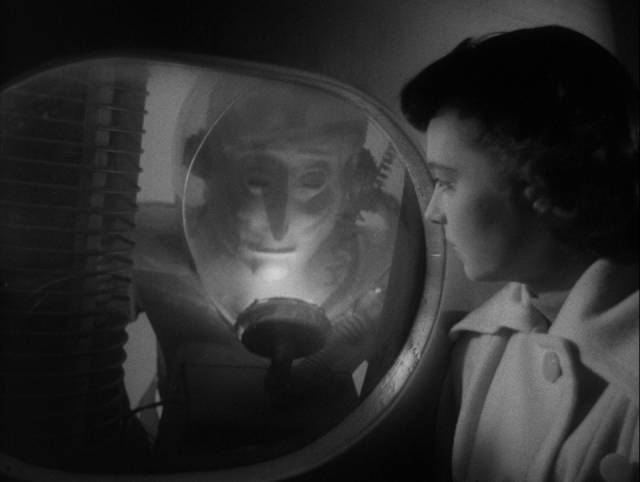
A figure like Edgar G. Ulmer frays the edges of Hollywood hegemony; in a career lasting more than three decades, he made something like fifty features in virtually every genre with, most of the time, little more than pocket change for budgets. Although he did make a couple of more or less mainstream features at the lower levels of the studio system – most notably The Black Cat (1934), just his second solo directorial effort, for Universal – much of his output was accomplished either on the fringes of the business for poverty row companies (particularly PRC, Producers Releasing Corporation) or completely outside the confines of Hollywood altogether, with films for audiences entirely neglected by the mainstream, including a series of Yiddish-language movies in the ’30s, and Moon Over Harlem (1939), a family drama with an entirely Black cast.
While Ulmer remains best-known for two particular features which managed to embody the essence of their genres – the perversely Gothic The Black Cat and his noir masterpiece Detour (1945) – his movies consistently display a level of craft and a genuine feeling for the expressive possibilities of cinema which makes them stand out from the mass of cheap exploitation crowding the landscape outside the walls of the mainstream industry. Whether toiling in those rocky, generally unfertile fields was merely a matter of poor luck or a conscious choice, it seems undeniable that Ulmer had a degree of creative freedom often denied those who worked within the lower rungs of the studio system. If by industry standards many of his movies might appear to be technically shaky, they are almost all imbued with a recognizable personality – as varied as his work is, Ulmer fits the definition of auteur. And if proof were needed that he was capable of delivering a well-crafted mainstream feature, you need look no further than his excellent dissection of the dark psychological underpinnings of American capitalism in Ruthless (1948).
Having started as a production designer/art director and assistant director in the ’20s (working with Fritz Lang and F.W. Murnau among others), Ulmer began his directing career with People On Sunday (1930), a masterpiece on which he collaborated with Robert Siodmak, Billy Wilder, Curt Siodmak and Fred Zinneman, all of whom went on to successful careers in the Hollywood studio system. Like them, Ulmer left Germany as the Nazis rose to power, but he was the first to arrive in Los Angeles, making his solo debut for Columbia Pictures (although the movie was released under the subsidiary banner of the Weldon Picture Corporation).
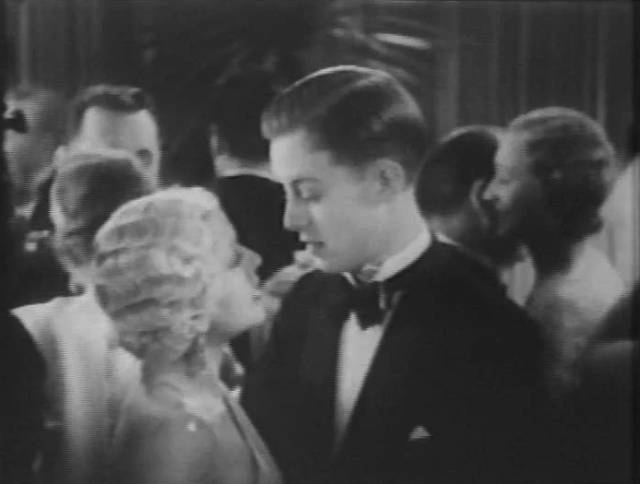
in Edgar G. Ulmer’s Damaged Lives (1933)
Damaged Lives (1933)
That first American feature, made on the cusp of the Production Code, was a “social issues” drama designed to educate audiences about the dangers of venereal disease. Based on a 1901 play by French playwright Eugene Brieux, which had been adapted three times during the silent era, Damaged Lives (1933) is a melodrama about the dreadful physical consequences of syphilis – referred to mostly as an “infection”, once or twice as “a venereal disease”, but never specifically by name – but also about the detrimental effects of social attitudes which, while trying to conceal the shameful ailment, manage to perpetuate it.
Pushy businessman Donald Bradley Jr (Lyman Williams) brushes off his fiancee Joan (Diane Sinclair) one evening in order to accommodate business contact Nat Franklin (Harry Myers), who wants to party. Don goes along unenthusiastically as the man gets drunk and eventually drags Don and the man’s date Elise Cooper (Charlotte Merriam) to what may be a brothel. Fed up, Don and Elise leave and, when he takes her home, the loosening atmosphere of the evening sees him taking the opportunity for a bit of casual sex – suggested, of course, but not shown.
Naturally, there’s a heavy price to pay. Elise calls with urgent news and after telling Don that she didn’t know that Nat had infected her and she may have passed the disease on to him, she shoots herself. Don asks his friend Dr. Bill Hall (Jason Robards Sr) about VD – “for a friend” – and is told it can be cured with a couple of years of treatment (this was back before antibiotics). Rather than risk embarrassment by going to a real doctor, Don goes to a quack whose ad he saw in the paper and pays for some pills he’s assured will cure him in a few months. Having covered up his indiscretion, Don duly marries Joan and when she becomes pregnant, the awful truth finally comes out.
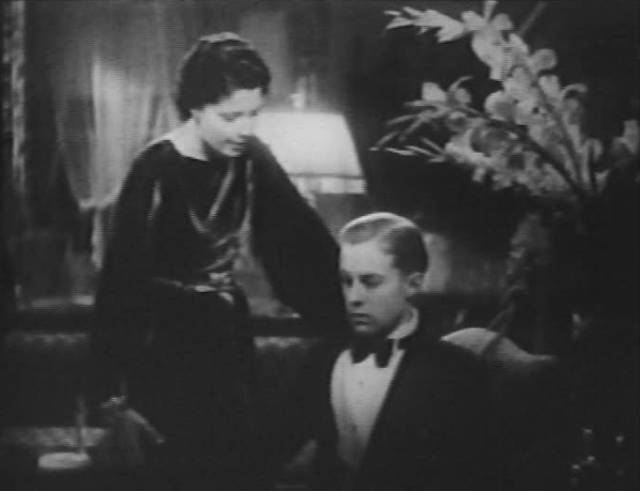
As Joan faints in horror, Don is given a tour of the VD clinic and shown the progressive stages the disease will take … and warned that the baby might be born with all manner of horrific problems including blindness and brain damage. Back home, having collapsed exhausted on the couch, Don sleeps as Joan calmly and methodically turns on the gas and lies down beside him so they can die together. Having hit rock bottom, the suicide attempt is interrupted and the pair face the future with the tentative hope that modern medicine will be able to save them after all.
While the disease itself is pretty awful, it’s the social attitudes surrounding it, the moral censure, the shame which inevitably attaches to something which carries the implication that its sufferers have actually engaged in sexual activity, which prevents people from seeing it with any objective detachment as an illness like any other.
Ulmer directs with a sense of drama which transcends the didactic purpose, the two suicide scenes being particularly effective. Elise, rather than being the traditional carrier of moral contagion, is a tragic victim herself, as is Joan as she calmly prepares her own escape from the moral horror. In older military training films (the usual site for warnings about VD), decent men were warned about the danger of disease-carrying prostitutes; here, the two women (giving the best performances in the movie) have been infected by careless men.
The Kino Blu-ray includes four short films Ulmer made at the end of the decade to promote awareness of a different, but nonetheless still somewhat stigmatized, illness. Commissioned by the National Tuberculosis Association, these fit into a more traditional type of educational project. Each film dramatizes the diagnosis and treatment of TB, in one case in a Hispanic family, in another a Black family. Perhaps the most surprising aspect is the impression the films give of a progressive social attitude – one young man is given training during his recovery in a sanatorium to prepare him for profitable work so he can get on with his life once cured. The emphasis is on communal efforts to improve health and well-being, reflecting the influence of the social shifts wrought by the New Deal. As in the Yiddish and Black features Ulmer had been making in the preceding years, there’s a sense of inclusiveness which doesn’t feel the need to proclaim itself, but simply accepts that society is multi-faceted.
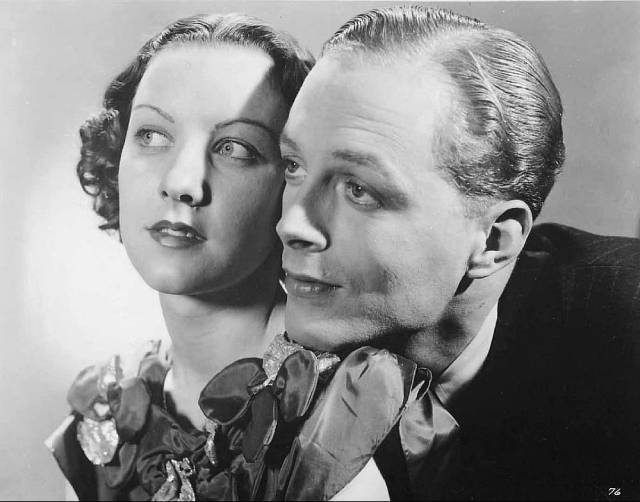
Phil Goldstone’s Damaged Goods (1937) is about
Kino’s disk also includes another adaptation of Brieux’s play, made just four years later. Damaged Goods (1937), directed by Phil Goldstone, whose credits are mostly silent movies from the ’20s, although he was a fairly prolific producer in the ’30s, arrived via a novel by Upton Sinclair which was based on the play. Surprisingly, this post-Code version is less coy about the disease, naming it explicitly as syphilis and adding a class element to the social attitudes which help to perpetuate the problem.
At his own bachelor party George Dupont (Douglas Walton) is attracted to one of the “good time girls” his friends have hired for the evening and ends up sleeping with Margie (Phyllis Barry). The narrative follows the general lines of Ulmer’s movie, but with some changes of emphasis. Margie, for instance, knows that she’s infected but doesn’t give a damn because she’s bitter about having been “initiated” by an older man in her teens (the implication is that she was raped) and passes along the consequences to the men whom she’s being paid to have sex with.
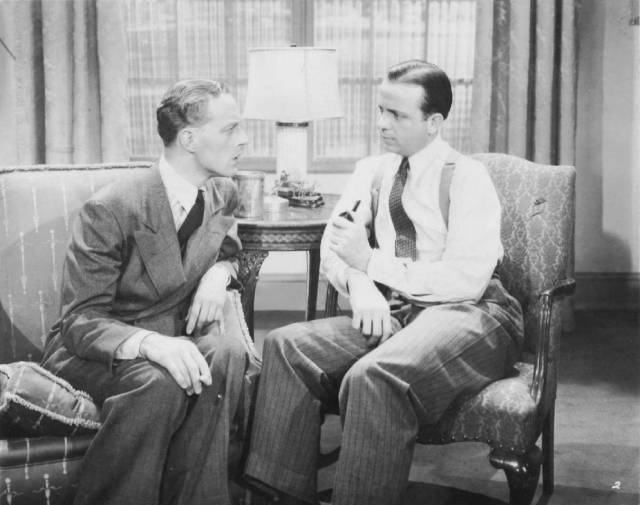
In time, George marries Henrietta (Arletta Duncan) and the disease is exposed when she becomes pregnant. The family, particularly George’s domineering mother (Esther Dale), try to keep a lid on the truth to avoid scandal, but Bertha (Greta Mayer), the wet nurse hired to care for the baby, overhears a conversation between Mom and Dr. Edward Walker (Pedro de Cordoba) about the potential of becoming infected herself through breastfeeding the baby. She demands extra money for keeping silent about the shameful secret. The social stigma surrounding VD merely perpetuates the problem, corrupting everyone it touches beyond the physical consequences.
Both movies are in surprisingly good condition given their age and their status as fringe productions. Both have decent production values and solid casts, though their subject matter would have kept many mainstream viewers away, relegating them to less reputable venues and an audience looking for something more salacious. While the features themselves are generally sober and serious, distributors had some supplementary options to satisfy an exploitation audience; the disk includes a pair of “lectures” which would have been tacked on to screenings, depending on the tolerance of individual communities. In each, an “expert” expounds on relationships and their attendant dangers (in one, “petting” in a parked car inflames a young man’s libido to the point where he attempts to rape his girlfriend – lesson: don’t even touch each other until marriage), leading to the horrors of VD.
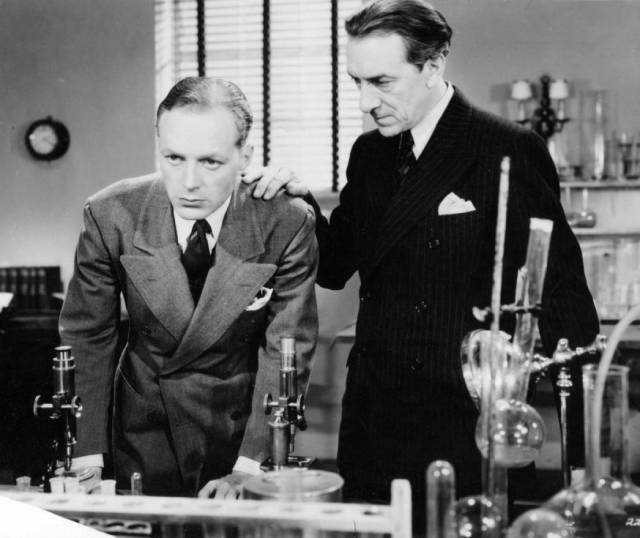
While one of the shorts is relatively tame, limiting itself to verbal admonitions, the other is disturbingly graphic, with close-ups of the consequences of infection (male and female genitals being poked and prodded to display horrific sores), as well as childbirth and a caesarean section. While all this might have put the fear of sexual transgression into viewers, it’s hard to imagine that it satisfied anyone’s prurient interest, or that it would have appealed to an audience of “respectable” people with an interest in the social issues supposedly being addressed. They do illuminate the strange confusions which resulted from the repression of open discussion/display of sexuality, however. People curious about the intimate body parts of the opposite sex had few opportunities to get a close-up look – the embarrassing prospect of being caught looking at pornography, or a supposedly respectable lecture on medical matters, though the latter suffered from the counter-productive drawback of having to display diseased parts.
*
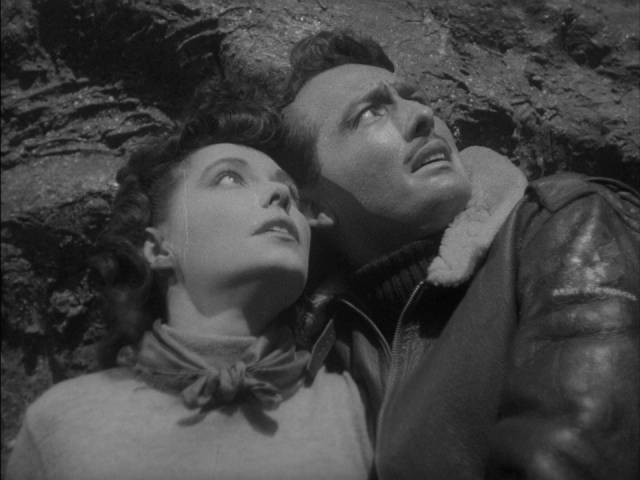
in Edgar G. Ulmer’s The Man from Planet X (1951)
Edgar G. Ulmer’s sci-fi
Just a month after the disk release of Damaged Lives, Kino brought out a triple feature Blu-ray from later in Ulmer’s career. Having spent a good part of the ’40s making films noirs, Ulmer turned his hand to the newly popular genre of science fiction. In fact, Ulmer got in on the trend early, with The Man from Planet X (1951) being released one month before Christian Nyby’s The Thing from Another World and six months before Robert Wise’s The Day the Earth Stood Still (both also 1951). Given that sci-fi by its nature tends to require a more substantial budget than film noir, the genre called on Ulmer’s ingenuity to create some sense of scale for his story of alien invasion. The results may not be convincing in conventional terms, but The Man from Planet X has enormous charm.
The story is simple and familiar from the many similar movies which followed: American reporter John Lawrence (Robert Clarke) arrives at the observatory of Professor Elliot (Raymond Bond) on a remote Scottish moor to find out about the discovery of a rogue planet heading towards Earth. When an object lands nearby, scientific curiosity turns into something more urgent. It’s a spaceship inhabited by a strange humanoid, which Lawrence, the Prof. and Dr. Mears (William Schallert) manage to capture. While Lawrence and Elliot try to communicate with the alien, the opportunistic Mears tortures it in an attempt to extract some advanced technological secrets he can profit from.
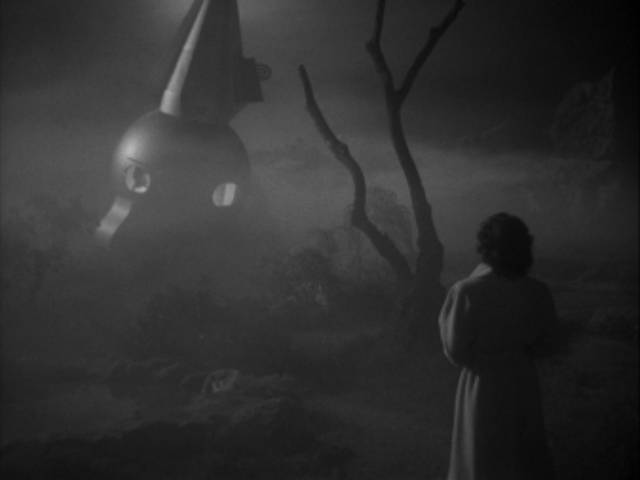
The alien escapes and uses its mind-control ray to enslave some locals who begin to fortify the site of the landing as the military turn up to thwart what appears to be the beginning of an invasion from Planet X. As in so many low-budget sci-fi and fantasy movies, the narrative itself is not really the important thing – though it’s interesting that the alien initially doesn’t appear to be particularly menacing and only starts using its technology to control people after Mears abuses it. What matters is the style and The Man from Planet X has plenty of that.
With the story mostly taking place at night and frequently in fog, Ulmer is able to conceal the limitations of the studio sets – even the exteriors of the moor appear to be shot on a soundstage. The real charm, though, comes from the miniatures. No one could mistake the tabletop landscapes for the real thing, but they’re beautifully crafted and shot with attention to atmospheric detail by John Russell (who in a long career also shot, among others, Orson Welles’ Macbeth, Frank Borzage’s Moonrise [both 1948] and Alfred Hitchcock’s Psycho [1960]) and effects cameramen Jack R. Glass and Jack Rabin. In addition to the look of the movie, the design of the alien is striking; even if the mask worn by actor Pat Goldin is rigid, it is strangely expressive and remains an iconic image from a decade rife with low-budget aliens.
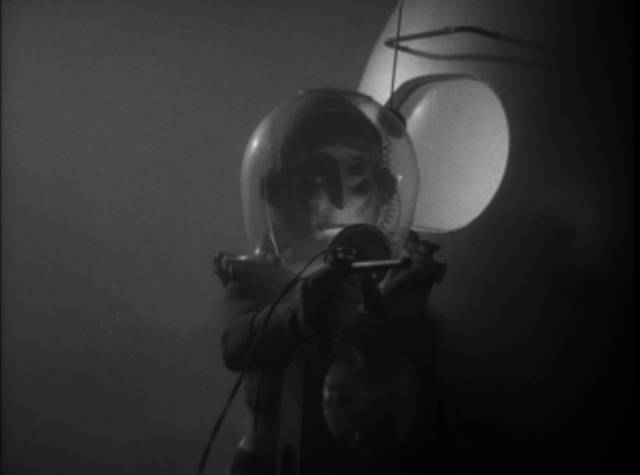
Ulmer didn’t return to the genre again until 1960 (unless you count the horror/sci-fi hybrid Daughter of Dr. Jekyll [1957], one of Ulmer’s lesser efforts), when he made a pair of features back-to-back for executive producers Robert L. Madden and John Miller which were distributed by American International Pictures. Both had typically limited budgets, but Ulmer once again brought his ingenuity to the projects. Both have more in common with television shows like The Outer Limits than theatrical sci-fi, which had gained a bit more sophistication by the turn of the decade (they were made the same year as George Pal’s The Time Machine).
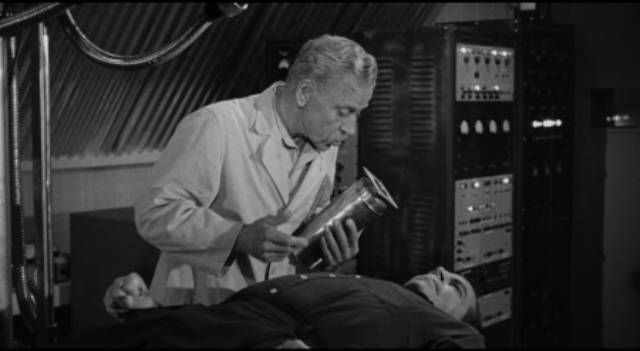
in Edgar G. Ulmer’s The Amazing Transparent Man (1960)
Clocking in at less than an hour, The Amazing Transparent Man is an example of a grandiose plot being constricted by limited resources. Major Paul Krenner (James Griffith) has plans to take over the world using a combination of nuclear war and an invisible army. For the latter, he has Dr. Peter Ulof (Ivan Triesault), a scientist who has developed an invisibility machine. Krenner keeps Ulof in line by holding his daughter Maria (Cormel Daniel) hostage. For the other part of his scheme, the Major breaks criminal Joey Faust (Douglas Kennedy) out of prison, turning him invisible so he can break into a vault and steal uranium.
Most of the movie takes place in a remote farmhouse, and the plan falls apart as various characters betray each other. The invisibility aspect is rendered with simple optical effects and actors miming being attacked by an unseen assailant. Not very ambitious, The Amazing Transparent Man is a typical bottom-of-the-bill movie from the tail end of the era of double-feature matinees.
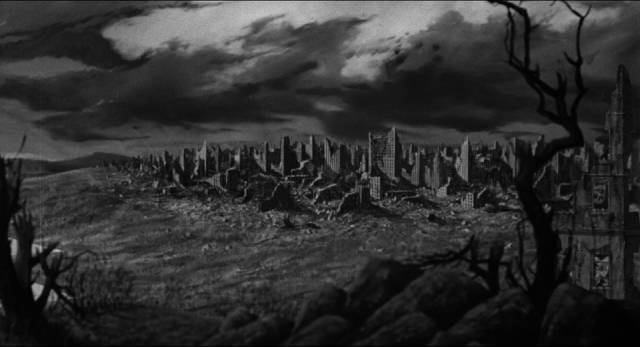
Beyond the Time Barrier reminds me a little of Wesley Barry’s Creation of the Humanoids (1962), another very talky depiction of a post-apocalyptic future with the remnants of humanity slowly dying out on sparse sets representing an underground redoubt. In Ulmer’s movie, the inhabitants are the sterile survivors of a devastating plague who have formed a vaguely fascist society at war with the mutants who inhabit the contaminated surface.
We are introduced to this world through Major William Allison (Robert Clarke again, also producing), who makes a test flight in an experimental rocket plane in 1960 and somehow passes through the “time barrier” in the upper atmosphere. Having disappeared from radar in 1960, he lands back at the base to find it in ruins. Exploring, he discovers a city also in ruins just before being taken prisoner by the underground dwellers.
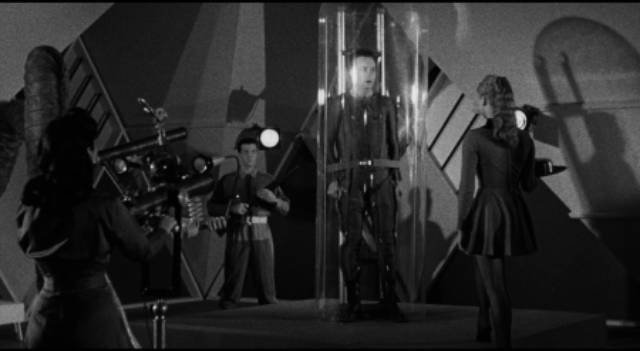
These people are all mute except for the supreme leader (Vladimir Sokoloff) and his second-in-command, the Captain (Boyd “Red” Morgan). Allison does eventually discover three others who can talk, a trio of scientists who, like him, are from the pre-plague past, held prisoner by the Supreme and the Captain to do research on finding a solution to the catastrophe. Meanwhile, the Supreme’s daughter Princess Trirene (Darlene Tompkins) has psychic powers and thus knows that Allison is not a threat – in fact, he may be part of the solution because his virile, uncontaminated self may help to produce a new fertile strain via the Princess herself, who happens to be the only fertile female left.
Allison and the trio of scientists see a better solution in getting the pilot back to his plane so that he can return through the time barrier and warn everyone in the past about what’s going to happen if they keep exploding atom bombs and contaminating the atmosphere. In order to effect an escape, Allison releases a bunch of mutants from their underground prison, leading to a slaughter of both mutants and human survivors as he breaks out, gets back to his plane, and returns home. Unfortunately for him, passing both ways through the barrier makes him an old man and there’s no guarantee that his warning will alter the behaviour of a world in the paranoid grip of the cold war.
*
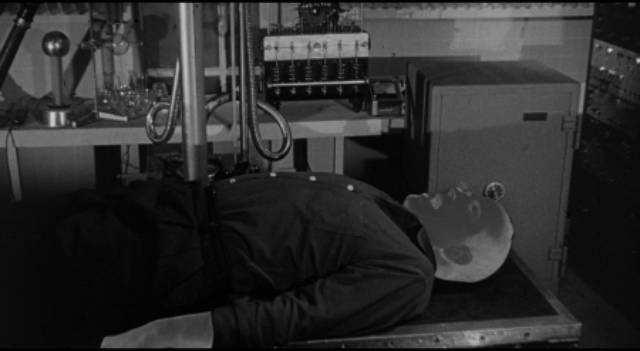
Although The Amazing Transparent Man and Beyond the Time Barrier are entertaining if minor B-movies, there’s no denying that they don’t live up to the best of Ulmer’s work from the ’30s and ’40s. Whether it’s the somewhat pedestrian nature of the scripts or simply a lack of resources, they only offer sporadic glimpses of Ulmer’s signature visual imagination. He had begun his career in film when only sixteen and had toiled away for four decades. Times had changed, the industry had changed and even though he was used to extremely small budgets, money had grown tighter for those working on the fringes. After Time Barrier, he made only two more features, both shot in Italy – the fourth adaptation of Pierre Benoit’s 1919 novel L’Atlantide, on which he replaced none other than Frank Borzage the year after making the two sci-fi movies, and The Cavern (1964), which bears some resemblance to Clive Rees’s The Blockhouse (1973), in which a multi-national group of soldiers and civilians are trapped in a cave during a bombardment during World War Two.
Ulmer remains a fascinating if somewhat enigmatic figure, an artist of obvious talents who worked diligently on the distant fringes of an industry which tends to revere only those who stick close to the centre and play by the rules. His films, the best of which have survived long after many more prominent productions have faded away, are artisanal wonders, full of imagination and insight into the shadier corners of human psychology and frequently surprising viewers with unexpected touches of visual beauty.
Comments